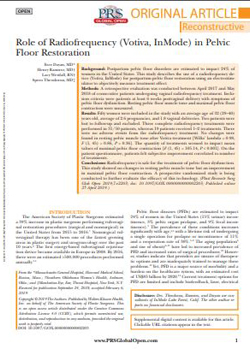 A new study, “Role of Radiofrequency (Votiva, InMode) in Pelvic Floor Restoration”, published on April 25, 2019 in the Plastic and Reconstructive Surgery – Global Open Journal highlights the safety and efficacy of using Radiofrequency (RF) energy for Pelvic Floor Restoration (PFR) after vaginal delivery. Authored by plastic surgeons Spero J. Theodorou of bodySCULPT® in NYC; Erez Dayan, MD; Henry Ramirez, MD; and Lacy Westfall, RN, the research reviews the use of a radiofrequency device, Votiva, InMode for postpartum pelvic floor restoration using an electrostimulator to objectively measure treatment effect.
A new study, “Role of Radiofrequency (Votiva, InMode) in Pelvic Floor Restoration”, published on April 25, 2019 in the Plastic and Reconstructive Surgery – Global Open Journal highlights the safety and efficacy of using Radiofrequency (RF) energy for Pelvic Floor Restoration (PFR) after vaginal delivery. Authored by plastic surgeons Spero J. Theodorou of bodySCULPT® in NYC; Erez Dayan, MD; Henry Ramirez, MD; and Lacy Westfall, RN, the research reviews the use of a radiofrequency device, Votiva, InMode for postpartum pelvic floor restoration using an electrostimulator to objectively measure treatment effect.
Around 24% of women in the United States are estimated to get affected by postpartum pelvic floor disorders. The occurrence of these conditions surges significantly with age, with a lifetime risk of undergoing a single operation for prolapse or incontinence of 11% and a reoperation rate of 30%. Studies indicate that providers are unsure of therapeutic options and are inadequately trained to manage these problems. Current treatment options for PFD are limited and include biofeedback, laser, electrical muscle stimulation, and in certain cases, operative intervention. However, advancements in the aesthetic field have introduced a number of energy-based devices, that include RF and laser (CO2, Er:YAG) devices which have been used for PFR to improve external genital appearance, vaginal laxity, and stress incontinence.
The American Society of Plastic Surgeons estimated a 39% increase in plastic surgeons performing vulvovaginal restoration procedures in the US from 2015 to 2016. Among both surgical and nonsurgical procedures, nonsurgical vulvovaginal therapy has been one of the fastest growing areas in plastic surgery and urogynecology over the past 10 years. This is mainly due to the attractive benefits – less downtime, discomfort, and cost – when compared to invasive surgical treatment.
The study points out that there is a surging interest in PFR which is a reflection of decreased stigmatization of female health issues and demonstrated safety and efficacy of energy-based devices. Despite this, there are barriers preventing sound scientific evaluation of these devices including: lack of objective outcome measures, use of unvalidated surveys, paucity of case/control studies, and inadequate follow-up. The researchers explain how the RF workstation, Votiva by InMode may potentially fill a treatment gap of pelvic floor disorders.
What is Votiva?
RF treatment may provide particular benefit in cases of disturbance to the genito-pelvic floor, where stretching of the vaginal introitus can lead to decreased sexual function, lubrication, genito-pelvic sensation, stress urinary incontinence, bowel incontinence, chronic pelvic pain, and pelvic organ prolapse. Votiva is a versatile radiofrequency workstation for women’s health and wellness, combining gentle volumetric heating with fractional coagulation of tissue. Used for vaginal rejuvenation, it is the first and only device on the market that helps to revive both the internal and external tissue of the vagina without the need for painful surgery or significant downtime. Votiva treatment combines 2 innovative radiofrequency devices – FormaV™ and Morpheus8 ™- to tighten loose tissues and reinforce vaginal skin structure and elasticity.

- Votiva with FormaV is 510k cleared for temporary improvements in blood circulation, muscle pain relief and muscle relaxation and is an adjunct to Kegel exercises (tightening of the muscles of the pelvic floor to increase muscle tone)
- Morpheus8 is fractional device for use in dermatologic and general surgical procedures for electrocoagulation
In this RF workstation study, a retrospective evaluation was conducted between April 2017 and May 2018 of consecutive patients (50 women with an average age of 32 (29-40) years old, average of 2.6 pregnancies, and 1.8 vaginal deliveries) undergoing vaginal radiofrequency treatment. Inclusion criteria were patients at least 6 weeks post vaginal delivery with symptoms of pelvic floor dysfunction. Resting pelvic floor muscle tone and maximal pelvic floor contraction were measured.
The study notes that there were no adverse events from the Votiva treatment and found a significant correlation between treatment and maximal contraction of pelvic floor muscles. Moreover, the patients say they felt subjective improvement correlated to number of treatments.
The study concludes mentioning a prospective randomized study that is being conducted to further evaluate the efficacy and role of this technology.
